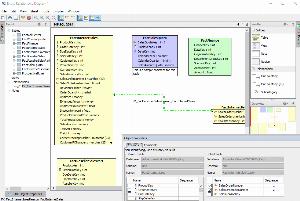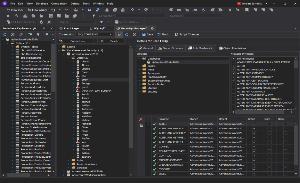Database design tools for Greenplum
List of tools that allow for the design of a database.
Database design is a set of activities aimed at improving the development, implementation, and maintenance of an enterprise data management system. Its main goal is to reflect the outline of the database system into real models: physical and logical. Database designers determine what data is to be stored inside the database, and how objects are to be related to each other.
Gleek.io
Gleek.io diagram maker is freemium text-to-diagram tool for developers and software architects. It enables the visual design of database online, in the cloud and from any browser. Create informal, UML, or entity-relationship diagrams - using just your keyboard.
| Desktop/Cloud: | Cloud |
|---|---|
| Generate DDL scripts: |
|
| Free edition: |
|
| ER Diagram: |
|
Aqua Data Studio Entity Relationship Modeler
Aqua Data Studio Entity Relationship Modeler (ER Modeler) helps in designing database models and uses the Forward Engineer feature to model entities and convert them into SQL Scripts, or Reverse Engineer existing databases to visualize a database model.
| Desktop/Cloud: | Desktop |
|---|---|
| Generate DDL scripts: |
|
| Free edition: |
|
| ER Diagram: |
|
RazorSQL
RazorSQL is an SQL query tool, database browser, SQL editor, and database administration tool. It provides visual tools to create, alter, describe, execute, and drop database objects such as tables, views, indexes, stored procedures, functions, triggers, and more.
| Desktop/Cloud: | Desktop |
|---|---|
| Generate DDL scripts: |
|
| Free edition: |
|
| ER Diagram: |
|
DbVisualizer
DbVisualizer is the universal database tool for developers, DBAs, and analysts. It is aimed to simplify database development and management. It provides tree-based navigation through database objects and let multiple objects to be displayed side-by-side.
| Desktop/Cloud: | Desktop |
|---|---|
| Generate DDL scripts: |
|
| Free edition: |
|
| ER Diagram: |
|
Toad Data Modeler
Toad Data Modeler enables developers, DBAs, and designers to create, maintain, and document quality database designs and structures across various database platforms.
| Desktop/Cloud: | Desktop |
|---|---|
| Generate DDL scripts: |
|
| Free edition: |
|
| ER Diagram: |
|
dbForge Studio for MySQL
dbForge Studio for SQL Server is an extremely helpful IDE for effective development of Microsoft SQL Server. With this tool, users can easily manage, administer, and analyze the Microsoft SQL Server's databases. THe IDE is great for performing any database tasks, and it males all processes much faster, too.
| Desktop/Cloud: | Desktop |
|---|---|
| Generate DDL scripts: |
|
| Free edition: |
|
| ER Diagram: |
|
ER/Studio
ER/Studio Data Architect helps to easily reverse- and forward-engineer, compare and merge, and visually document data assets across multiple platforms and data sources. It enables data professionals to better manage data models and metadata in complex and dynamic enterprise environments.
| Desktop/Cloud: | Desktop |
|---|---|
| Generate DDL scripts: |
|
| Free edition: |
|
| ER Diagram: |
|
Qlik Data Catalyst
Qlik Data Catalyst is a metadata driven data catalog that has technical and business descriptions, data profiles, data lineage, and data tags that make data search and delivery simple. It builds a secure, enterprise-scale catalog of all the data your organization has available for analytics, no matter where it is.
| Desktop/Cloud: | - |
|---|---|
| Generate DDL scripts: | - |
| Free edition: |
|
| ER Diagram: | - |
The database design process can be very complicated. The more complex the system, the more sophisticated the tool is needed. Their functionality can vary greatly, however, core features include:
• creating and editing database objects,
• database architecture modeling,
• visualization of a database schema,
• tracking relationships between entities,
• grouping logically related objects into clusters,
• diagrams overview.
Database designer tools enable building graphical models and generating DDL scripts on their basis. The script describes data and relations between entities in the designed database. Furthermore, the tools enable reverse engineering (visualization of the model from the SQL script).
Key factors of creating a reliable and well-organized database are:
• a properly designed data structure,
• establishing what data should be stored in particular objects,
• how objects should be related to each other.
All of them can be improved by using the relevant Database design tool. Additionally, some of them allow the visual representation of data using ERD, makes it easier to visualize even more complex schemas.
Without proper software, development is based on raw code. This increases the risk of errors at the initial stage. The tools allow users to edit the visual layout using simple drag-and-drop functions. With a user-friendly interface, browsing the structure is possible even for non-IT people.
We have created a list of tools that support the process of creating database structure and its content. Our list includes free database design tools as well as advanced, more professional data management tools.
 SQL Server
SQL Server
 Oracle
Oracle
 MySQL
MySQL
 PostgreSQL
PostgreSQL
 Amazon Redshift
Amazon Redshift
 Azure SQL Database
Azure SQL Database
 DBT
DBT
 Google Big Query
Google Big Query
 IBM DB2
IBM DB2
 MariaDB
MariaDB
 SAP HANA
SAP HANA
 Snowflake
Snowflake
 SQLite
SQLite
 Teradata
Teradata
 Vertica
Vertica











